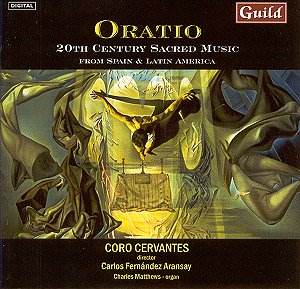20th century sacred music from
Spain and Latin America. Well, not quite so indeed since Alberto
Ginastera is the only Latin American composer featured here whereas
Ernesto Halffter (as well as his brother Rodolfo) was born in
Spain but settled in Mexico much later. So, most works here were
composed by Spanish composers of various generations. Curiously
enough, the oldest composer is Pau Casals whose O vos omnes
was composed in 1932 whereas the youngest composer is César
Cano, b.in 1960, whose Speculum in ænigmatem ,
which ends this programme, was awarded 1st prize at
the "Juan Bautista Comes" Choral Competition in 1997.
It would be completely idle on my part to detail
all the works recorded here, though some definitely deserve some
more comments. Let us say that most pieces are generally fairly
simple, direct and quite beautifully made. Though some may be
more familiar, a number of composers will be new to many of you.
Such is Nemesio Otaño whose substantial miniature cantata
Tota Pulchra for tenor, chorus and organ is featured
here or José Antonio Donostia (pseudonym of José
Gonzalo Zulaica y Arregui), a Capuchin apparently well-known as
a folklorist and a musicologist, whose beautifully made O
Iesu mi dulcissime for mixed chorus is sometimes redolent
of Warlock’s bittersweet harmonies, or Fernando Remacha, a lesser-known
composer from Navarra belonging to the same generation as Mompou,
Guridi and Ernesto Hallfter, represented here by his fairly traditional,
but quite moving Veni sponsa Christi beautifully
set for women’s voices and organ.
As already mentioned, the oldest composer here,
Pau Casals, is represented by his short anthem O vos omnes,
a very fine setting of the three first lines only of the same
text set by Ginastera. Needless to say, that his fine setting
is definitely more traditional than Ginastera’s. Many of the other
composers represented here roughly belong to the same generation
b.at the turn of the 20th Century. Ernesto Halffter’s
Oratio from 1935 is an impressive, though rather
austere setting for alto, bass and chorus. The name and work of
Jesús Guridi has recently been brought into the public
again thanks to a Naxos disc of some of his orchestral and vocal
music. His fairly early Tantum ergo is a tender
setting redolent of Fauré whereas his impressive Final
para gran organo of 1960 brings Franck, Widor and Vierne
to mind, which is not surprising since he – as many other Spanish
composers of his generation – went and studied in Paris. Mompou’s
beautiful setting Ave Maria somewhat reminded me
of Rubbra’s Tenebrae Motets whereas Rodrigo’s own
setting of the Ave Maria is also fairly simple, with some
mild dissonance without which his music would not be what it is.
Joaquím Homs’ setting of Les llums del món
("The Lights of the World" on a short Catalan text by
S. Sánchez-Juan) for male voices is a real gem for all
its brevity.
One of the real surprises here is Montsalvatge’s
organ work Aureola para una imagen de Ramón Amadeu
which often reminded me of Messiaen, with its abrupt changes of
light and shades suggesting changing light through stained glasses.
This quite impressive piece should appeal to enterprising organists
looking for some worthwhile, unusual repertoire.
The younger generations are represented here
by Cristóbal Halffter (the nephew of Ernesto and Rodolfo)
with his quite early, uncharacteristic but extremely fine Panis
Angelicus for female voices, Javier Busto, Antón
García Abril and by the youngest man here César
Cano whose Speculum in ænigmatem is in a slightly
more advanced, but still quite accessible idiom.
Ginastera’s Hieremiae prophetae lamentationes
Op.14 were written in 1946-1947 in the States where he
had settled after leaving Peron’s Argentina. The choice of texts
and the setting certainly reflect the circumstances of the time,
i.e. the composer’s exile and the aftermath of World War II. The
opening section O vos omnes is tense, furious and even
aggressive at times, whereas the second section Ego vir videns
paupertam meam is more inward and brooding. The final section
Recordare attempts at finding some hopeful outlet to the
accumulated tension of the preceding section. Needless to say
that this impressive setting is quite demanding, in terms of vocal
strength, rightness and intonation, and is obviously meant for
professional groups, unlike many other pieces here that could
be sung – quite satisfyingly – by good amateur choirs. This work
was new to me and I hope that the times are now ripe for recording
companies to consider Ginastera’s large-scale choral-orchestral
works that are still conspicuously absent from his discography.
I have been quite impressed by the London-based
Coro Cervantes’s immaculate, precise and assured singing that
makes all these pieces sound easy, though they are not always
easy to sing at all. The recorded sound is superb and the production
up to Guild’s best standards. I urge you to listen to this, for
there is much fine stuff here and – most importantly – wonderful
singing by all concerned.
Hubert Culot


